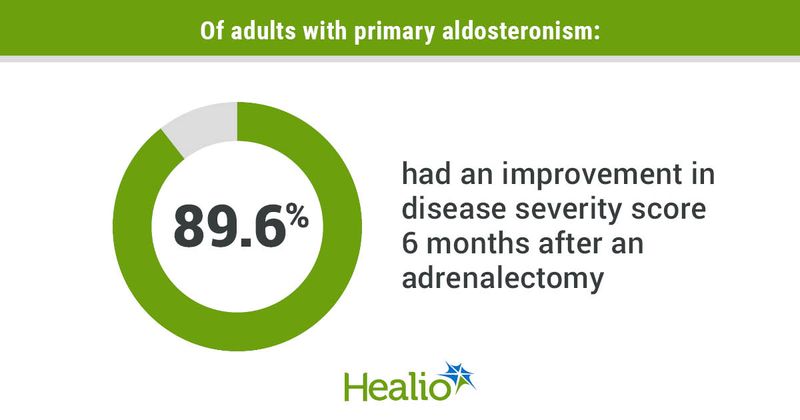Disease severity improves for most patients with primary aldosteronism after adrenalectomy
Key takeaways:
- Of adults with primary aldosteronism, 89.6% had a decrease in disease severity score after vs. before adrenalectomy.
- Those with mild disease severity before adrenalectomy had the highest cure rate.
Adults with primary aldosteronism had improvements in disease severity after undergoing an adrenalectomy, according to findings published in Endocrine Practice.
In a single-center retrospective study, researchers developed a disease severity score based on the American College of Cardiology (ACC) and American Heart Association (AHA) stages of hypertension, daily dose of potassium supplementation and daily defined dose of antihypertensive medications, with a higher scoring indicating worse disease severity. Median disease severity scores improved for 89.6% of the study group 6 months after an adrenalectomy compared with before surgery.

“Our results show that although a clinical cure may not be a realistic outcome for most patients with primary aldosteronism, adrenalectomy provides a clinical improvement in most patients, and the degree of improvement can be measured using this new disease severity score,” Eren Berber, MD, MBA, vice chair of endocrine surgery and director of robotic endocrine surgery at Cleveland Clinic’s Adrenal and Neuroendocrine Tumor Center, and colleagues wrote.
Researchers collected data from 201 adults with primary aldosteronism who underwent an adrenalectomy from 2000 to 2023. A primary aldosteronism disease severity score was calculated for each adult before their adrenalectomy and 6 months after the procedure.
When using aldosteronoma resolution score or primary aldosteronism surgical outcome criteria for normal blood pressure levels, 15.9% of the study group had a complete clinical cure of primary aldosteronism 6 months after adrenalectomy. When ACC and AHA criteria was used, 6.5% of adults had a complete cure 6 months after their procedure. At least one antihypertensive medication was being used by 89.6% of participants 6 months after adrenalectomy.
The median disease severity score for the study group declined from 16.3 points before adrenalectomy to 10 points at 6 months after procedure (P < .0001). Of the study group, 89.6% had a lower disease severity score after their adrenalectomy compared with before surgery. Disease severity score improved by a median of 33.3%.
“We believe the new score ... will provide more realistic expectations to patients preoperatively, especially in a population with high cardiovascular risks,” the researchers wrote. “Our subjective experience is that most of our patients were satisfied with the benefit obtained from adrenalectomy despite the absence of a cure due to improvements in their subsequent BP management.”
The study group was stratified based on pre-adrenalectomy disease severity into a mild severity group with a score of less than 15 points (n = 71), a moderate severity group with a score of 15 to 19 points (n = 79) and a severe disease severity group with a score of 20 points or more (n = 51). Adults with mild disease severity had a higher complete cure rate (15.5%) than those with moderate disease severity (1.3%) or severe disease severity (2%; P < .0001). Median disease severity score improvement from before adrenalectomy to after the procedure was 42.9% in those with severe disease severity compared with 28.5% in the moderate disease severity group and 27.3% for adults with mild disease severity pre-adrenalectomy (P = .04).
The researchers cautioned that the disease severity score’s utility is limited to measuring clinical outcomes and validation studies using the new score are needed.
